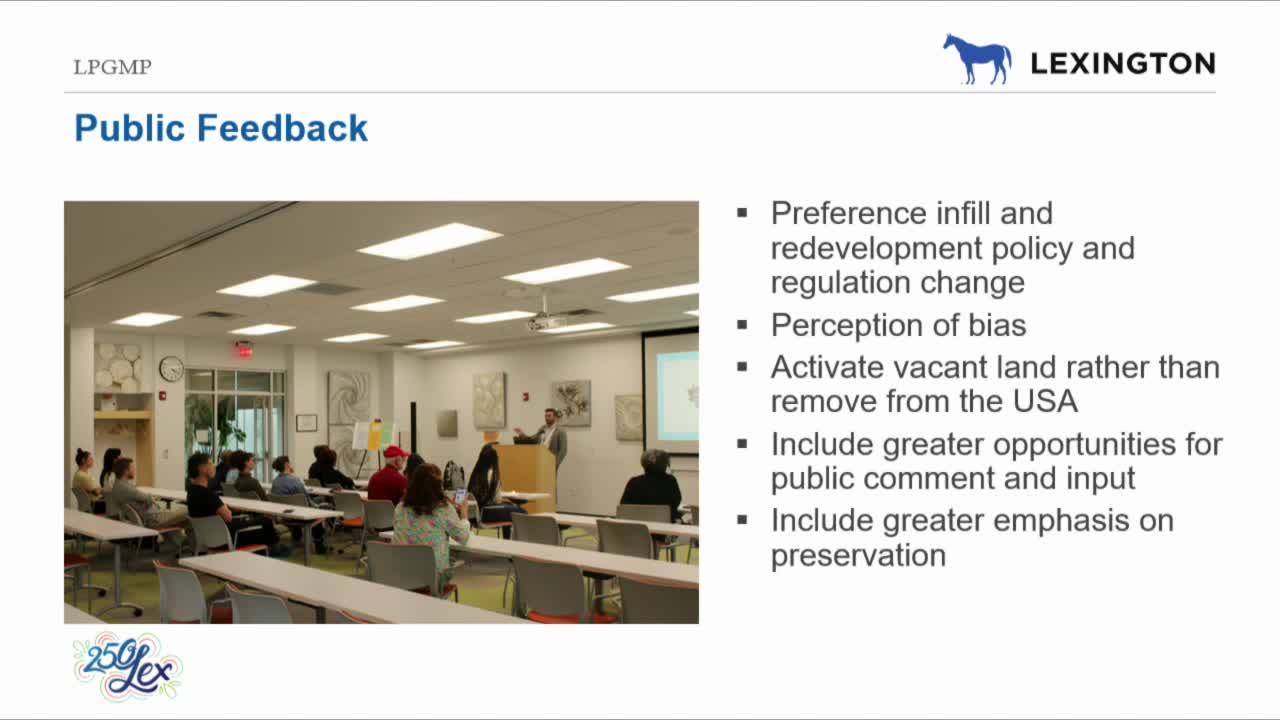Lexington Urban County Council Reviews Growth Trends and Limits on Urban Expansion
September 09, 2025 | Lexington City, Fayette County, Kentucky
This article was created by AI summarizing key points discussed. AI makes mistakes, so for full details and context, please refer to the video of the full meeting. Please report any errors so we can fix them. Report an error »

The Lexington General Government and Planning (GGP) Committee convened on September 9, 2025, to discuss urban expansion, land use, and community needs in Fayette County. The meeting focused on balancing urban growth with preservation efforts, emphasizing the necessity for a transparent process in decision-making.
The committee acknowledged differing perspectives on urban expansion and preservation, noting that neither viewpoint fully captures the complexities of the issue. A significant point raised was the desire to utilize vacant land within the current urban service area, alongside a call for continued public involvement in final decisions regarding urban planning.
A key agenda item was the introduction of guardrails to limit speculative expansions. These measures include caps on expansion and a defined process for urban growth, aimed at ensuring responsible development. The committee presented an updated flowchart detailing changes since the last meeting, which included a five-year growth trends report that clarifies residential needs based on projected population growth.
The report outlines a formula to calculate the residential needs for the next 20 years, using data from the Kentucky State Data Center and the American Community Survey. This calculation will help determine the number of dwelling units required to accommodate future growth while considering existing residential zones.
The committee also discussed the Urban County Council's role in reviewing policy and regulatory changes, emphasizing that any identified residential needs must be addressed before considering adding land to the urban service area. Additionally, if the council opts to include more acreage, it would be limited to a maximum of 30 years of residential need, preventing large speculative expansions.
Further discussions highlighted the challenges of maintaining land for economic development while accommodating residential needs. The committee proposed a separate process for addressing projected employment growth, which would involve a special economic development need assessment. This approach aims to ensure that land designated for job growth is preserved and supported by the community.
In conclusion, the meeting underscored the importance of a structured and transparent approach to urban planning in Lexington, balancing the needs for residential growth and economic development while engaging the community in the decision-making process. The committee plans to continue refining these strategies in future sessions.
The committee acknowledged differing perspectives on urban expansion and preservation, noting that neither viewpoint fully captures the complexities of the issue. A significant point raised was the desire to utilize vacant land within the current urban service area, alongside a call for continued public involvement in final decisions regarding urban planning.
A key agenda item was the introduction of guardrails to limit speculative expansions. These measures include caps on expansion and a defined process for urban growth, aimed at ensuring responsible development. The committee presented an updated flowchart detailing changes since the last meeting, which included a five-year growth trends report that clarifies residential needs based on projected population growth.
The report outlines a formula to calculate the residential needs for the next 20 years, using data from the Kentucky State Data Center and the American Community Survey. This calculation will help determine the number of dwelling units required to accommodate future growth while considering existing residential zones.
The committee also discussed the Urban County Council's role in reviewing policy and regulatory changes, emphasizing that any identified residential needs must be addressed before considering adding land to the urban service area. Additionally, if the council opts to include more acreage, it would be limited to a maximum of 30 years of residential need, preventing large speculative expansions.
Further discussions highlighted the challenges of maintaining land for economic development while accommodating residential needs. The committee proposed a separate process for addressing projected employment growth, which would involve a special economic development need assessment. This approach aims to ensure that land designated for job growth is preserved and supported by the community.
In conclusion, the meeting underscored the importance of a structured and transparent approach to urban planning in Lexington, balancing the needs for residential growth and economic development while engaging the community in the decision-making process. The committee plans to continue refining these strategies in future sessions.
View full meeting
This article is based on a recent meeting—watch the full video and explore the complete transcript for deeper insights into the discussion.
View full meeting
